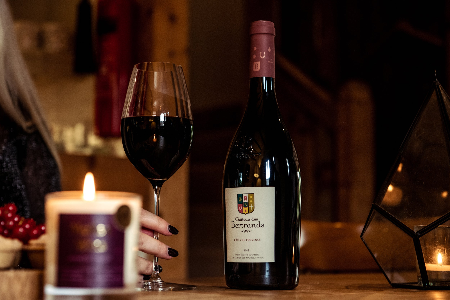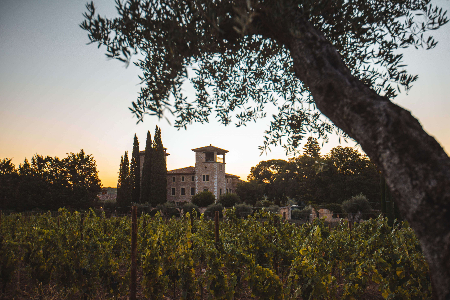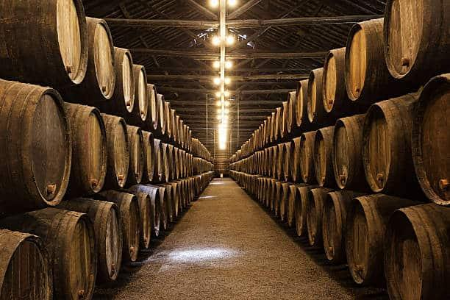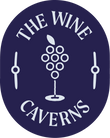Indulge your senses in a captivating narrative that weaves together the threads of history, culture, and a beloved libation—the timeless elixir of wine.
As we dive into the annals of time, we uncover how wine has evolved from a humble discovery to a symbol of sophistication and pleasure.
The history of wine is a fascinating journey through time, showcasing its evolution and impact on civilisations throughout the ages.
From its ancient origins to its modern-day production and consumption, wine has played an influential role in societies' social, cultural, and economic aspects.
In this blog post, we will dive into the rich history of wine, exploring its origins, the evolution of winemaking techniques, and its significance in ancient civilisations.
So grab a glass of your favourite vintage and join us as we explore the captivating history of wine.

The Ancient Origins of Wine
Wine has delighted and captivated people for centuries, and its origins are deeply rooted in ancient history.
The discovery and cultivation of wine can be traced back thousands of years, providing us with a fascinating glimpse into the early civilisations that first embraced this remarkable elixir.
The story of wine begins in the cradle of civilisation, the ancient Near East. It is believed that around 6000 BCE, in the region known as Mesopotamia (modern-day Iraq and Iran), the first grapevines were cultivated and wine production began.
The favourable climate and fertile soil of this region provided an ideal environment for grape cultivation, allowing the early inhabitants to experiment with winemaking.
Archaeological evidence, such as the remains of ancient pottery jars and grape seeds, suggests that winemaking techniques were refined and expanded upon over time.
The ancient Mesopotamians, known as the Sumerians, played a pivotal role in the development and spread of winemaking.
They not only perfected the art of viticulture but also documented their winemaking processes on clay tablets, providing valuable insights into the early history of wine.
Wine held a significant cultural and religious significance in ancient societies. It was considered a gift from the gods and was often used in religious ceremonies and offerings.
The ancient Egyptians, for example, associated wine with the god Osiris and believed that it played a vital role in the afterlife.
Both the wealthy elite and the common people enjoyed wine, which was an integral part of their daily lives.
As civilisations expanded and traded with one another, the knowledge and appreciation of wine spread to other ancient cultures.
The Phoenicians, renowned seafarers and traders, played a crucial role in disseminating winemaking techniques throughout the Mediterranean region.
They established colonies and trading posts along their routes, introducing winemaking to regions such as Greece, Italy, and France.
In Ancient Greece, wine took on a new level of importance and became deeply ingrained in their culture and mythology.
The Greeks not only consumed wine but also celebrated its virtues through poetry, art, and philosophical discourse.
They believed that wine had the power to bring joy, inspire creativity, and even heal the sick.
The Greeks also embraced the concept of terroir, recognising the influence of soil, climate, and vineyard location on the character of the wine.
The Romans, inheritors of Greek culture, further expanded the cultivation and appreciation of wine.
They recognised the economic potential of wine production and established vineyards throughout their vast empire, from Spain to Gaul (modern-day France) and beyond.
The Romans also introduced innovations such as the use of wooden barrels for ageing and transporting wine, which revolutionised the industry.
The ancient origins of wine set the stage for its enduring legacy and global significance.
From the early civilisations of Mesopotamia and Egypt to the Greek and Roman empires, wine became a symbol of cultural identity, social status, and trade.
It was not merely a beverage but an integral part of daily life, shaping the course of history and leaving an indelible mark on human civilisation.
The Evolution of Wine Making Techniques
Wine making techniques have undergone a remarkable evolution throughout history, with advancements in technology, scientific knowledge, and cultural practices shaping the way wine is produced.
This section delves into the key milestones and transformations that have influenced the art and science of winemaking.
1. Ancient Beginnings:
The origins of wine making can be traced back to ancient civilisations such as the Mesopotamians, Egyptians, and Greeks.
In these early times, grape cultivation and wine production were closely intertwined with religious rituals and social customs.
Wine making techniques during this period were relatively simple and involved crushing grapes by foot, allowing the juice to ferment naturally, and storing the wine in clay amphorae.
2. The Roman Influence:
The Roman Empire played a significant role in shaping the development of wine making techniques.
The Romans introduced improved methods such as pruning vines, cultivating specific grape varieties, and implementing more sophisticated pressing techniques.
They also recognised the importance of vineyard location and soil quality, leading to the concept of terroir, which emphasises the influence of environmental factors on a wine's character.
3. The Monastic Tradition:
During the Middle Ages, wine-making knowledge was preserved and advanced by monastic orders.
Monks dedicated themselves to refining winemaking techniques, experimenting with different grape varieties, and improving fermentation processes.
They also played a pivotal role in expanding vineyard plantings across Europe, carefully selecting suitable regions, and introducing new grape varieties.
4. The Age of Enlightenment:
The Enlightenment period witnessed significant advancements in wine making.
Scientists and scholars began to study the chemical and biological processes behind fermentation, leading to a deeper understanding of yeast's role and the factors influencing wine quality.
This era saw the adoption of more controlled fermentation methods, temperature regulation, and the use of wooden barrels for ageing, allowing for more precise control over wine production.
5. Technological Innovations:
The 19th and 20th centuries marked a turning point in winemaking with the introduction of groundbreaking technologies.
The invention of the wine press, the steam-powered crusher, and the development of temperature-controlled fermentation tanks revolutionised the industry.
These advancements enabled larger-scale production, improved consistency, and facilitated the creation of new wine styles.
6. Sustainable and Organic Practices:
In recent decades, there has been a growing emphasis on sustainable, natural and organic wine making practices.
Many producers have adopted environmentally friendly methods, including organic farming, biodynamic principles, and minimising chemical interventions.
These approaches aim to preserve biodiversity, promote soil health, and reduce the environmental impact of wine production.
7. Modern Winemaking Techniques:
Today, winemakers have access to an array of tools and techniques to produce high-quality wines.
From advanced irrigation systems to optical grape sorting machines, the wine industry continually embraces innovation.
Furthermore, the understanding of vineyard management, grape genetics, and microbiology has deepened, enabling winemakers to make more informed decisions throughout the production process.
The evolution of wine making techniques is a fascinating journey that spans thousands of years.
From the ancient traditions of foot stomping grapes to the cutting-edge technology employed in modern wineries, wine making has continually evolved to meet the demands of changing times.
This rich history has shaped the diverse range of wines we enjoy today, showcasing the skill, knowledge, and passion of winemakers throughout the ages.

The Influence of Wine on Ancient Civilisations
Wine, with its roots deeply embedded in ancient history, has played a significant role in shaping the cultures and societies of various civilisations.
From its origins in the fertile crescent of the Middle East to its spread across the Mediterranean and beyond, wine has been intertwined with the lives of people in ancient times.
This section explores the profound influence of wine on several prominent ancient civilisations.
Ancient Mesopotamia: The Birthplace of Wine
The story of wine begins in ancient Mesopotamia, present-day Iraq, where evidence suggests that winemaking originated around 6000 to 4000 BCE.
The region's favourable climate and fertile soil proved ideal for grape cultivation, allowing the early Mesopotamians to experiment with fermenting grapes and producing wine.
Initially, wine in Mesopotamia had religious significance, and it was closely associated with various deities, often being used in rituals and offerings.
Ancient Egypt: Wine as a Symbol of Royalty
In Ancient Egypt, wine held a prestigious position and was reserved for the elite and royalty.
The Egyptians embraced winemaking, cultivating vineyards along the Nile River and adopting techniques from the Mesopotamians.
Wine became an integral part of their religious ceremonies and burial practices, with jars of wine frequently being placed in tombs to accompany the deceased in the afterlife.
Moreover, the ancient Egyptians traded wine with neighbouring civilisations, thus establishing the prominence of wine along ancient trade routes.
The Greeks: Dionysus and Wine Culture
The ancient Greeks elevated the significance of wine to unparalleled heights, attributing its discovery to the god Dionysus.
Wine held an essential role in Greek mythology and religious festivals, often associated with revelry and celebration.
Beyond its religious aspects, wine became a symbol of social bonding, intellectual discourse, and artistic expression in Greek society.
The Greeks also pioneered the establishment of vineyards in new territories as they colonised lands around the Mediterranean, spreading the art of winemaking across their vast empire.
The Romans: Wine for Pleasure and Health
The Romans inherited their wine culture from the Greeks but took it to a whole new level.
People from all social classes enjoyed wine in ancient Rome, where it became a staple of daily life.
The Romans not only consumed wine for pleasure but also believed in its medicinal properties, using it as an antiseptic and a digestive aid.
The Romans expanded vine cultivation to various regions of Europe, including France, Spain, and Germany, laying the groundwork for the modern wine-producing regions we recognise today.
Wine in China: The Silk Road Connection
While wine predominantly flourished in the Mediterranean and its surrounding regions, it also found its way to ancient China through the famous Silk Road trade network.
Initially, Chinese wine was made from fruits like plums and peaches, but after exposure to grapes via trade, they began incorporating grape wine into their culture.
Chinese wine-making techniques further developed during the Tang dynasty, with wine becoming an essential aspect of their rituals, ceremonies, and artistic expression.
India and Persia: Wine in Ancient Sanskrit Texts
In ancient India, references to wine can be traced back to the Vedic period, with alcoholic beverages like "sura" being mentioned in sacred texts. Similarly, Persia, now modern-day Iran, had a rich wine culture, and it played a prominent role in their literature and courtly life.
Wine's Influence and Global Exchange
The widespread consumption and trade of wine in various ancient civilisations fostered cultural exchange and diplomatic relations.
As wine traversed borders, it carried with it elements of each culture, influencing and being influenced by the customs, rituals, and traditions of different societies.
This intermingling of wine cultures paved the way for future innovations in winemaking techniques, vineyard management, and wine appreciation.
Through its journey through ancient civilisations, wine transcended its humble beginnings to become a symbol of power, luxury, and cultural significance.
Its influence extended far beyond mere intoxication, leaving an indelible mark on the arts, religion, trade, and social fabric of ancient societies.
As we delve deeper into the history of wine, we uncover its continuing legacy and its enduring impact on the world as we know it today.
The Medieval Period: Wine in Monasteries and Castles
During the Medieval period, wine played a significant role in the lives of people living in Europe, particularly within monasteries and castles.
Wine production and consumption were closely intertwined with religious practices, social status, and even healthcare.
This section explores the importance of wine during the Medieval period, shedding light on its production, distribution, and cultural significance.
Wine Production in Monasteries
Monasteries were central to wine production during the Medieval period. Monks, renowned for their dedication to agriculture and viticulture, played a pivotal role in cultivating vineyards, perfecting winemaking techniques, and preserving grape varieties.
The monks' extensive knowledge and meticulous approach contributed to the refinement and expansion of wine production.
Within the walls of monastic communities, vineyards were carefully tended, and wineries were equipped with the necessary equipment for crushing grapes, fermenting the juice, and storing the resulting wine.
Monks dedicated considerable time and effort to perfecting winemaking techniques, experimenting with different grape varieties, and developing new methods of fermentation and ageing.
Their expertise and commitment to quality laid the foundation for future advancements in winemaking.
Moreover, monasteries provided a stable and controlled environment for winemaking, ensuring consistent production regardless of external factors such as weather conditions or political unrest.
The monastic life offered protection to vineyards and wineries, allowing the monks to focus on cultivating grapes and crafting exceptional wines.
Wine in Castles and the Nobility
Wine also held great significance in the castles and noble households of the Medieval period. It was not only consumed as a beverage but also served as a status symbol, displaying wealth and power.
The presence of extensive wine cellars within castles was a testament to the importance placed on wine by the nobility.
The nobles and aristocrats of the Medieval period took pride in showcasing their extensive wine collections, which often included rare and exotic vintages.
Wine cellars were meticulously maintained, with appropriate storage conditions such as cool temperatures and humidity levels to preserve the quality of the wines.
Additionally, wine was an essential component of feasts and banquets hosted by the nobility.
These lavish gatherings served as occasions for displaying opulence and grandeur, and wine played a central role in the festivities.
The quality and variety of wines served at these events were indicative of the host's social standing and hospitality.
Wine's Role in Healthcare and Daily Life
Beyond its religious and social significance, wine also played a role in healthcare and daily life during the Medieval period.
The wine was believed to have medicinal properties and was often prescribed by physicians to treat various ailments. Its consumption was thought to aid digestion, strengthen the body, and alleviate certain symptoms.
In addition to its medicinal value, wine was a staple beverage for many individuals, serving as a safer alternative to water, which could often be contaminated.
The fermentation process eliminated harmful pathogens, making wine a reliable and safer choice for hydration.
It also provided a source of calories and nutrients, particularly for those living in regions where food scarcity was a constant concern.
Wine in the Renaissance: A Symbol of Wealth and Power
During the Renaissance, wine emerged as a powerful symbol of wealth and influence, playing a significant role in the social, cultural, and political landscape of the time.
The Renaissance period, spanning roughly from the 14th to the 17th century, was characterised by a renewed interest in classical learning, arts, and literature.
This cultural revival, combined with the rise of prosperous merchant classes and the patronage of the aristocracy, led to a flourishing wine culture that extended beyond mere consumption.
In the Renaissance, wine was not only cherished for its taste and intoxicating effects but also for its symbolic value. It became a status symbol, demonstrating one's wealth, power, and refinement.
The nobility and the upper classes, in particular, embraced wine as a means of displaying their social standing and sophistication. Lavish banquets and feasts were organised, where the quality and quantity of wine served reflected the host's prestige.
Wine cellars became an essential feature of grand residences and palaces during this period.
These cellars were meticulously stocked with a wide variety of wines, often sourced from different regions and countries.
Owning an extensive wine collection became a testament to one's affluence and taste.
The storage and ageing of wine became a science, with advancements in cellar construction and temperature control techniques, ensuring that the wines matured gracefully over time.
Wine consumption during the Renaissance was also accompanied by elaborate rituals and etiquettes.
The wine was not just a beverage; it was an integral part of social gatherings and courtly life.
Refined table manners and knowledge of wine etiquette became essential skills for those aspiring to be part of the elite circles.
The act of serving and drinking wine was elevated to an art form, with specialised vessels, such as ornate goblets and decanters, being used to enhance the sensory experience.
Additionally, the influence of wine extended beyond the dining table. It played a crucial role in diplomatic negotiations, as wine was often used to establish alliances, broker deals, and solidify relationships between rulers and states.
The exchange of prized wines as gifts became a diplomatic tradition, showcasing the wealth and generosity of the giver while also reinforcing diplomatic ties.
Artists and writers of the Renaissance period frequently depicted wine in their works, further cementing its status as a symbol of luxury and power.
Paintings often featured scenes of opulent banquets and celebrations, with wine goblets prominently displayed.
Poets and playwrights celebrated wine in their verses and plays, recognising its ability to inspire creativity and intellectual pursuits.
The Renaissance period marked a significant turning point in the history of wine, where it transformed from a beverage of necessity into a cultural icon.
The association of wine with wealth and power continued to influence wine consumption patterns and preferences for centuries to come.
Even today, the allure of fine wines and the desire to experience the luxury and prestige associated with them can be traced back to the Renaissance period.

The Impact of Wine on Colonisation and Trade Routes
During the period of colonisation, European powers such as Portugal, Spain, France, and England sought to establish colonies in distant lands to exploit valuable resources, including wine-producing regions.
These colonial powers recognised the economic potential of wine and its ability to generate substantial profits through trade.
The exploration and colonisation of the New World, particularly the Americas, had a profound impact on the global wine industry.
Spanish conquistadors and settlers, such as Hernán Cortés, brought grapevines from Europe to Mexico, establishing vineyards and introducing winemaking practices to the region.
Similarly, Portuguese explorers, like Bartolomeu Dias and Vasco da Gama, ventured into Africa and Asia, establishing trading posts and introducing vine cultivation in regions such as South Africa and India.
As European powers established colonies, they sought to create self-sufficient economies.
Wine production became an integral part of these colonies, as it provided a valuable commodity for both local consumption and export.
The establishment of vineyards in these new territories allowed colonisers to meet the growing demand for wine in their home countries while also reducing reliance on imports.
Furthermore, wine played a crucial role in the establishment of trade routes. Merchants recognised the demand for wine across different regions and sought to capitalise on its popularity.
Wine became a sought-after trade commodity, facilitating the exchange of goods and ideas between diverse cultures and civilisations.
The trade of wine along established routes, such as the Silk Road and the Mediterranean Sea, promoted cultural exchange and influenced the spread of winemaking techniques.
For example, the Phoenicians, known for their seafaring skills, played a crucial role in the dissemination of wine production methods throughout the Mediterranean region.
Their extensive trade networks allowed them to introduce grapevines and winemaking knowledge to regions such as modern-day Lebanon, Greece, and Italy.
The influence of wine on trade routes extended beyond the Mediterranean. European merchants, driven by the desire for profit, ventured into new territories, such as the East Indies and the Americas, seeking opportunities for trade and colonisation.
Wine served as a valuable trading commodity in these ventures, fostering economic ties and cultural interactions between Europe and these regions.
The Modern Era: Wine Production and Consumption Today
In the modern era, wine production and consumption have reached unprecedented levels, with a global industry that spans continents and cultures.
The advancements in technology, globalisation, and changing consumer preferences have significantly influenced the production, distribution, and enjoyment of wine in today's world.
One of the notable developments in the modern era is the application of scientific knowledge and technology to winemaking.
With the aid of advanced equipment and techniques, winemakers can now monitor and control various aspects of the winemaking process, resulting in greater consistency and quality of wines.
From vineyard management to fermentation and ageing, precision tools allow winemakers to optimise every stage of production.
The use of modern vinicultural practices has also revolutionised wine production. Scientific advancements in soil analysis, irrigation systems, and vineyard management have enabled grape growers to cultivate vines in regions previously deemed unsuitable for winemaking.
This has led to the emergence of new wine regions and the production of high-quality wines in unexpected locations.
Moreover, the globalisation of the wine industry has opened up new markets and opportunities for both producers and consumers.
Wine-producing countries have expanded their exports to reach a wider audience, while consumers now have access to a diverse selection of wines from around the world.
This has contributed to the exploration and appreciation of different grape varieties, winemaking styles, and regional characteristics.
In recent years, there has been a growing trend towards organic wine and sustainable winemaking practices.
Consumers are increasingly concerned about the environmental impact of wine production and are seeking wines made with minimal chemical intervention.
As a result, many winemakers have adopted organic, biodynamic, or sustainable farming methods, reducing the use of pesticides and promoting biodiversity in vineyards.
The rise of online platforms and e-commerce has also transformed the way wine is bought and sold.
Wine enthusiasts can now easily access information, reviews, and recommendations online, enabling them to make informed choices and discover new wines.
Online wine retailers and subscription services have made it convenient for consumers to have wines delivered to their doorstep, further expanding the reach of the wine market.
Another significant shift in the modern era is the changing wine consumption patterns.
While wine has long been associated with formal occasions and celebrations, it has now become a part of everyday life for many people.
Wine bars, tasting rooms, and wine-focused events have become popular social venues where individuals can explore different wines and interact with fellow wine enthusiasts.
Overall, the modern era has seen remarkable advancements in wine production and consumption.
Through the application of scientific knowledge, technological innovations, and changing consumer preferences, the wine industry has evolved to meet the demands of a global market.
As we continue into the future, it is likely that we will witness further innovations, trends, and new frontiers in the world of wine.
The Future of Wine: Trends and Innovations
As we enter the 21st century, the world of wine is experiencing exciting trends and innovative advancements that are shaping its future.
From technological innovations in vineyard management to changing consumer preferences, the wine industry is evolving to meet the demands of a dynamic and global market. In this section, we will explore some of the emerging trends and innovations that are expected to drive the future of wine.
1. Sustainable and Organic Practices:
With an increasing focus on environmental sustainability, many winemakers are adopting organic and biodynamic farming practices.
These methods prioritise the use of natural fertilisers, cover crops, and the preservation of biodiversity, resulting in wines that are not only environmentally friendly but also express the unique characteristics of their terroir.
Consumers are becoming more conscious of the ecological impact of their choices and are actively seeking out wines produced using sustainable practices.
2. Climate Change Adaptation:
Climate change is significantly impacting wine regions around the world. Rising temperatures, changing weather patterns, and unpredictable growing seasons pose challenges for grape growers and winemakers.
In response, the wine industry is adapting by implementing strategies such as planting different grape varieties, adjusting harvesting times, and implementing irrigation techniques to combat water scarcity. Additionally, research and technology are being used to develop new disease-resistant grape varieties that can thrive in warmer climates.
3. Innovative Winemaking Techniques:
Advancements in winemaking technology and techniques are revolutionising the industry.
From the use of artificial intelligence in vineyard management to precision winemaking tools, such as optical sorting machines and automated fermentation systems, winemakers now have access to cutting-edge technology that can improve the quality and consistency of their wines.
These innovations allow for greater control over the winemaking process, resulting in wines that better reflect the winemaker's vision.
4. Exploration of New Grape Varieties
Winemakers are constantly experimenting with new grape varieties to create unique and exciting wines.
This includes rediscovering old, lesser-known grape varieties and adapting them to different growing conditions, as well as developing hybrid grapes that are resilient to climate change.
5. Innovations in Ageing Techniques
Traditional ageing processes are being challenged by innovative techniques.
Old and new methods, such as concrete egg-shaped tanks, amphorae, and extended ageing on lees, are being employed to enhance the flavours and textures of wines.
6. Diverse Wine Styles
Consumer preferences are evolving, and winemakers are creating a wider range of wine styles to cater to different tastes.
From natural wines to low-alcohol options, there is an increasing emphasis on diversity and innovation in the wine industry.
7. Alternative Packaging:
While traditional glass bottles continue to dominate the wine market, alternative packaging options are gaining popularity.
Bag-in-box wines, cans, and Tetra Paks offer convenience, portability, and reduced environmental impact.
These packaging formats are particularly appealing to younger consumers who seek more accessible and sustainable options.
Additionally, alternative packaging helps to extend the shelf life of wine, reducing the potential for spoilage and waste.
8. Wine Tourism:
Wine tourism has seen significant growth in recent years, with more people visiting vineyards and wineries for immersive experiences.
Wineries are investing in visitor centres, wine tasting rooms, and hospitality services to cater to this growing demand.
Wine regions are becoming popular tourist destinations, offering wine enthusiasts the opportunity to learn about the winemaking process, explore vineyards, and sample a variety of wines.
This trend is expected to continue as wine tourism contributes to local economies and fosters a deeper appreciation for wine.
9. Exploration of New Wine Regions:
As traditional wine regions face challenges due to climate change, winemakers are exploring new frontiers.
Emerging wine regions in countries such as China, India, and Brazil are gaining recognition for their quality wines.
Additionally, lesser-known regions within established wine-producing countries are being discovered and celebrated for their unique expressions of grape varieties.
The exploration of new wine regions not only diversifies the global wine market but also presents exciting opportunities for winemakers and consumers alike.
The future of wine is shaped by evolving consumer preferences, environmental concerns, and technological advancements.
Sustainable and organic practices, climate change adaptation, innovative winemaking techniques, alternative packaging, wine tourism, and the exploration of new wine regions are all trends and innovations that are set to influence the wine industry in the years to come.
As wine continues to hold a special place in our culture and celebrations, these developments promise an exciting and vibrant future for wine enthusiasts around the world.
Conclusion
The history of wine is a fascinating journey that has evolved over time. From its ancient origins in the Middle East to its influence on ancient civilisations and its role in the medieval period, wine has played a significant role in human culture and society.
Through advancements in winemaking techniques and the impact of wine on colonisation and trade routes, it has become a global industry enjoyed by people from all walks of life.



















